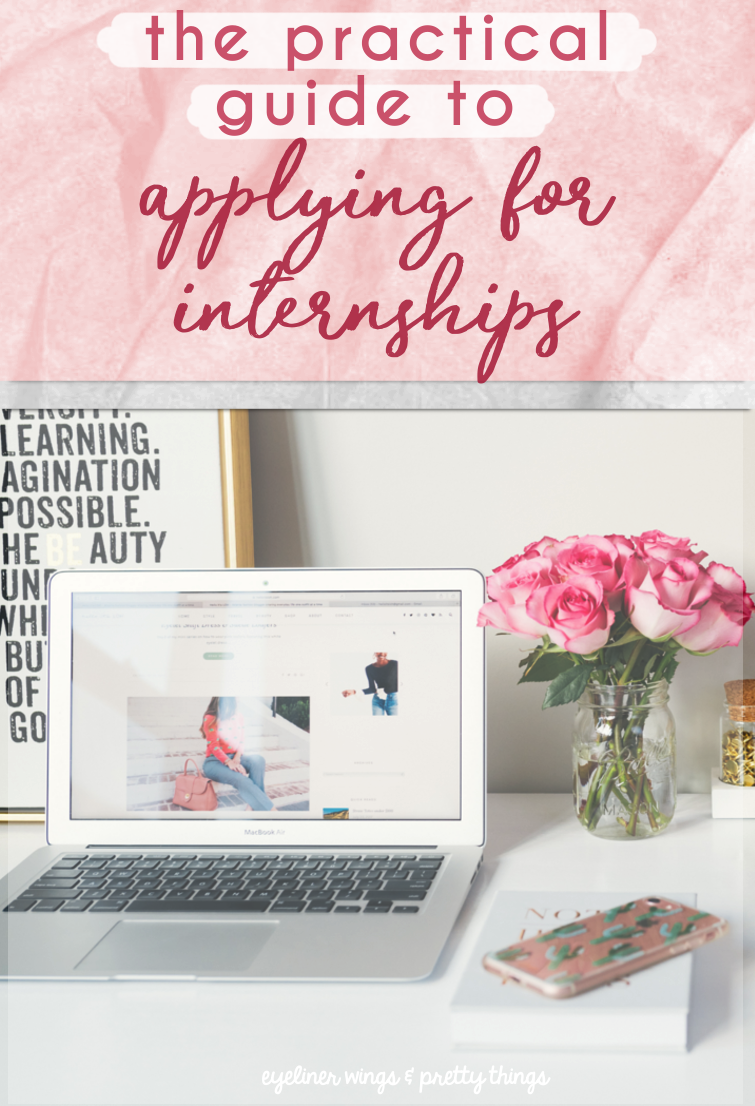
I’ve made guides (including one from five years ago!!) about finding and getting internships, but I think now’s a good time to share an updated, more thorough one with even more helpful info.
Now that I have my dream job, have sorted applications and helped hire interns (also known as fellows), and have had multiple internships, I think I’m much better equipped to give some practical advice and handy tips.
So, whether you’re a college freshman or a senior looking for your next post-grad move, here’s a practical guide to applying for internships.
Part I: Where and how to look for the right internships 
Googling your city and a range of keywords + “internship” can be a bit of a time sink, and academic advisors aren’t always the best resource to help you find what you’re looking for. Because of this, it’s important to make sure you’re using your time wisely during the process, and it starts by knowing where to look and how to do so.
Make a list of companies you’d like to work for, then search their competitors and add those to your to-apply list
It can be hard to find companies and jobs without searching through thousands of internship listings, so I advise you think of a few companies you admire or aspire to work for and then do a quick search to find their competition.
Once you have your list, check each site for internship listings and track it all in a spreadsheet. Be sure to do this early and mark down deadlines so you can figure out which positions to prioritize.
Oftentimes, your dream company’s competition is, well, competition for a reason and you might just end up falling in love with the place. And, if you can believe it, working for a competitor will make your resume stand out when you apply to your top choice down the road.
I know that, in editorial, if you worked for one of our competitors it looks great because we know that you’ve worked somewhere that does similar great work
Quick Example: If you aspire to work at Teen Vogue or Nylon, also apply to jobs at Cosmo, HuffPost, and smaller fashion sites.
On Twitter, follow people, especially managing editors or HR staff, from companies you love
Oftentimes managing editors and those who work in HR or recruiting will tweet about new opportunities and job listings as soon as they go up.
Check LinkedIn and make sure your status is set to actively searching
I’ve found a number of listings on LinkedIn, and it was one of my go-to places to check when I was applying for internships. The search system is quite easy to use and it’s often easier to spot legitimate listings than it is on some other jobs boards.
Apply even if you don’t meet every qualification, but note that some are non-negotiable
If you don’t check off every single box, apply anyway. But if the internship’s time frame is not possible for you (ie: you’ll be in college and not available 40 hours a week as the listing requires), you may not want to bother as there is often a reason behind the dates or seasons.
Oftentimes there’s some wiggle room with start and end dates (if you want to start a week later or end a week earlier) or if you’re going to need a few days off in the middle of the program, but if your timelines and availability really don’t match up, don’t waste your time and theirs.
Start early and don’t wait until just before the deadline to apply
I can’t emphasize this enough! Oftentimes internships applications open up and close months before the position will actually begin. In addition, some companies will sort applications early and start interviewing and reviewing candidates weeks before the application deadline. And, if they find someone great before you’ve even submitted your cover letter, you’re simply out of luck.
You don’t need to be the first one to apply to a listing, but I’d suggest applying at least a week before the applications are officially due.
Apply to something you want, even if you’ve been rejected for it in the past
My favorite internship that led to my job is actually one I applied for a year or two earlier! Don’t be afraid to give something another shot, even if you’ve been turned down in the past (especially since it could’ve been for a range of reasons).
Just be sure not to use the same application that you did last time, just in case.
Part II: Organizing applications and using smart strategies
![]()
Now that you’ve found what you want to apply for, it’s important that your resumes, cover letters, and other materials are looking good and staying neat.
For starters, always mark down what you apply for and when, especially so you can track your progress and avoid applying for something more than once!
Cast a wide net, but don’t apply to everything — especially if you’re looking at multiple positions in one company
A great tip for you from someone who’s seen many internship applications — many companies can see which jobs you applied for within that company, plus how many times you applied. And, unsurprisingly, it doesn’t look good if you’ve applied to 10 internships in five different branches of the company. It implies you don’t really have a passion or know what you want to do, or that you just want a position, any position!
So, save yourself time and effort, and apply to one or just a few related positions at a company. Don’t use the same exact cover letter, either, since it’s often easy to check and it can seem insincere.
Plus, the fewer positions you apply for, the better you can be about really focusing your time and attention on your applications to make them strong and smart.
Example: Apply for the beauty editorial fellowship and fashion editorial fellowship, but don’t apply to those plus a bunch of internships for the news team, travel team, and strategy team. It makes it seem like you’re not passionate about any of the positions.
Rename your resume and cover letter files
This is great to help you stay organized, plus it’s important to remember recruiters can typically see these file names. So if you’re submitting a resume called “NYLON_RESUME_2017” for a 2020 job listing at Vogue or one called “RESUME_GOOD_AdvertisingJob,” it doesn’t look great.
It’s best to include your last name, the year, and the company in your file title, especially in case it ever gets misplaced.
Example: If you’re applying to a job at Revlon, save your resume as “REVLON_LASTNAME_2020RESUME.” It’ll be easy for everyone to find and organize.
Keep track of when you apply to things so you know when to follow up
Oftentimes it’s not possible to follow up, especially since many companies use forms to receive applications. But if you’re submitting an application via email, you’ll want to follow up after about a week and a half after you apply, or a week after the application’s deadline.
If no one responds, I’d advise letting it go. But I think it’s always worth following up at least once, if possible. Just be patient and avoid sending email after email! Set one reminder to go off after you apply so you remember to follow up, and do so in a polite and concise way.
Don’t make your cover letter entirely about yourself and what this internship would mean for you
Yes, your cover letter should shine a spotlight on your achievements and skills … but, ultimately, the person reading it wants to know what you can offer their team or company.
Because of this, I suggest highlighting the skills and achievements that are specifically relevant to the position and ensuring you tie it back to the listing, even if it’s in a subtle way. This way, you’re making the cover letter about you while also making it feel more personalized to the position and company you’re aiming for.
Example: Instead of simply saying “I am a master at packaging stories with great headlines.” Say, “I am a master at packaging stories, which is something [TEAM AT COMPANY] does incredibly well, especially since you strive for punchy, fun headlines that are straightforward and honest but still make you want to click.”
Make sure your resume is pretty, clean, and not weighed down by nonsense
I would like to start by saying that, unless you’re applying for a modeling position or one that specifically asks for a photo of you, don’t include a headshot. There’s also no need to include all of your high school achievements, either, unless you’re in your first year or two of college and have nothing else to pop on.
In addition, if you need to cut anything, start by cutting your activities/interests/hobbies, especially since it’s often quite irrelevant to a position.
And, even if you’re in a field that’s not super creative, I encourage you to create a clean, pretty resume with a minimal design and a pop of color or two. Just make sure it’s easy to read and your name is clearly written at the top. The stylized, not-Times-New-Roman resumes really do stand out.
Avoid the “easy apply” option, even if it’s tempting
The thought of only having to send your resume and not having to take any time to craft a fresh cover letter is *chef’s kiss*. I’ve been there! This option is so easy and so tempting after you’ve applied to 40 internships.
Buuut the shortcut might not pay off. Think of it this way: A hiring manager is going to be far more impressed with someone who took the time to craft a cover letter than they are with someone who just sent in their default resume. It can also show how little you care about a position if you just send in a resume and nothing else.
That said, if it’s an internship you’re not particularly passionate about and you simply just want to feel good about applying to something, treat yourself to an “easy apply”! But, at the very least, make sure you tweak your resume and adjust it to best fit the position’s requirements.
And, honestly, if a company doesn’t want a cover letter or anything beyond just a resume, you might want to dig into the position a little bit deeper to see if there’s a reason the application requires so little.






